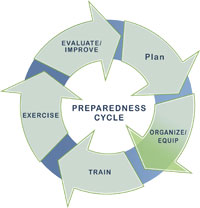Organize and Equip

Organizing and equipping provide the human and technical capital stock necessary to build capabilities and address modernization and sustainability requirements. Organizing and equipping include identifying what competencies and skill sets people delivering a capability should possess and ensuring an organization possesses the correct personnel. Additionally, it includes identifying and acquiring standard and/or surge equipment an organization may need to use when delivering a specific capability. This element of the Cycle is guided by stakeholder needs, national priorities identified in the National Preparedness Guidelines, capabilities-based planning described in the Target Capabilities List (TCL), and relevant legislation, policies, doctrine, and risk assessments.
Resource typing is the categorization and description of response resources that are commonly exchanged in disasters through mutual aid agreements. Resource typing definitions can give emergency responders the information they need to make sure they request and receive the appropriate resources during an emergency or disaster. Credentialing documents minimum professional qualifications, certifications, training and education requirements that define baseline criteria expected of emergency response professionals and volunteers for deployment as mutual aid to disasters.
System Assessment and Validation for Emergency Responders
System Assessment and Validation for Emergency Responders (SAVER) Program assists emergency responders in making procurement decisions. The SAVER Program conducts objective assessments and validations on commercial equipment and systems, and provides those results along with other relevant equipment information to the community in an operationally useful form. SAVER provides information on equipment that falls within the categories listed in the DHS Authorized Equipment List (AEL).
The Responder Knowledge Base (RKB) is a national information resource for emergency responders, funded by the FEMA National Preparedness Directorate. The RKB Mission is "to provide Emergency Responders, purchasers, and planners with a trusted, integrated, on-line source of information on products, standards, certifications, grants, and other equipment-related information."
Citizen Corps Partners and Programs
Citizen Corps Partners and Programs provide resources for public education, outreach, and training and offer volunteer service opportunities for citizens to support first responders, disaster relief activities, and community safety efforts. These resources include the Community Emergency Response Team Program, which educates people about disaster preparedness for hazards that may impact their area and trains them in basic disaster response skills, such as fire safety, light search and rescue, team organization, and disaster medical operations.
Emergency Management Assistance Compact
The Emergency Management Assistance Compact (EMAC) is a national interstate mutual aid agreement that enables states to share resources during times of disaster. EMAC is administered by the National Emergency Management Agency (NEMA).
Regionalization
FEMA is working with the FEMA Regional Offices to increase the role and capacity of regions to implement and coordinate the application of preparedness programs. This will allow the FEMA Regional Offices to be the single point of contact for DHS/FEMA programs and activities for states within their region. Having the FEMA Regional Offices be the hub for engagement with FEMA and for requesting resources will streamline interactions.
Last Modified: Tuesday, 14-Apr-2009 12:37:00 EDT
